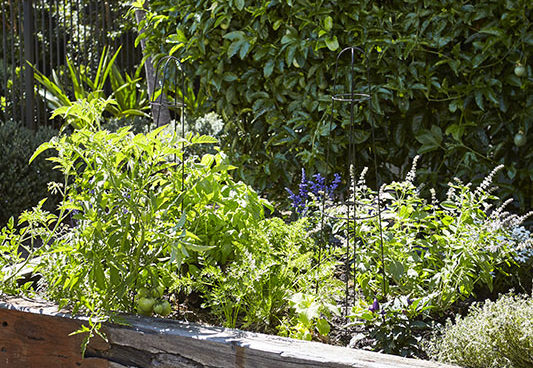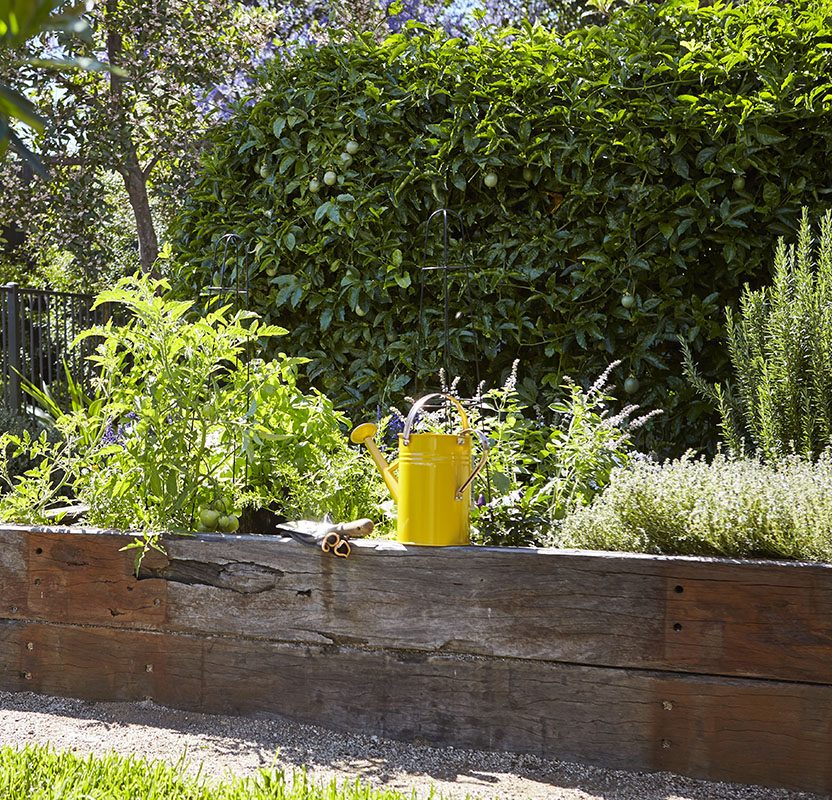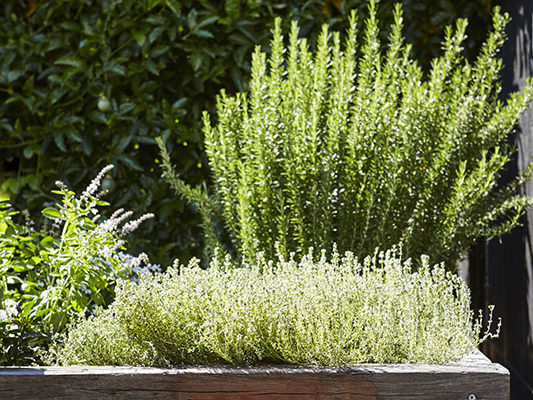The remarkable popularity of herb gardening during the Covid-19 crisis highlighted the natural longing within many of us, to nurture plant life.
Even self-confessed ‘non-gardeners’ admitted that nature beckoned in the midst of isolation, helping them to find comfort in planting while tending to a variety of verdant edibles.
Rosmarinus officinalis (Rosemary) and Thymus vulgaris (Thyme) thriving in full sunlight – the Marrickville garden – Pepo Botanic Design.
“During lockdown, we noticed an increase in the number of people planting herbs in garden beds, planter boxes and pots,” says Pepo Director, Nicola Cameron. “So many in our community rediscovered the joy of growing herbs and it was wonderful to be a part of the resurgence.”
Our favourite herbs
Not surprisingly, herbs are widely known and appreciated for their aroma and edibility.
Flavours range from sweet and peppery, to earthy and pungent, and we have selected our top five picks:
- Ocimum basilicum (Basil): a deliciously fragrant, quick growing herb that prefers warm, moist soil and sunny conditions – given its Mediterranean origins. It is perfect for making pesto and tomato-based sauces and is well known for assisting digestion, combatting depression, and detoxifying the body. Basil is also well regarded for its anti-inflammatory properties.

Annual flowering plants like Salvia officinalis (Sage) produce edible flowers and attract bees and insects to assist with pollination – the Marrickville garden – Pepo Botanic Design.
- Allium schoenoprasum (Chives): an incredibly versatile plant that prefers full sun and cooler temperatures, typically thriving in nitrogen rich soil. As a nutrient-dense food, Chives are a good source of vitamin C and calcium and help to promote the flow of blood.
Pepo recommends harvesting Chives once they reach a height of around 20 centimetres, using sharp secateurs to snip a few finger widths above the base of the plant.
- Mentha piperita (Mint): this prolific grower tends to take over, so we suggest giving it plenty of space and even consider planting it away from other herbs in its own pot. Mint is fast growing and thrives in light soil with good drainage, preferring full sun to partial afternoon shade.
Its fresh flavour and bright, sweet scent make it an ideal cooking accompaniment. This versatile herb can be used in salads and pasta, as well as healing herbal teas, given it can assist with digestion and also relieve headaches and stress.

A mix of complementary herbs displaying varying colours and textures – the Marrickville garden – Pepo Botanic Design.
- Petroselinum crispum (Parsley): originating from the Mediterranean, this bright green curly-leafed biennial prefers a sunny spot in well-drained soil. The French curly-leaf and Italian flat-leaf varieties both have a unique way of tying many cooking flavours together – adding a bright note to most dishes.
Parsley is rich in vitamin C and is a good source of vitamin K as well, which supports bone and heart health.
- Tropaeolum majus (Nasturtium): this often-overlooked edible is actually classified as a weed, given its tendency to grow vigorously along roadsides, railways and waste areas! But we love it regardless. Its appealing bright green leaves and vibrant flowers make it as attractive, as it is delicious.

Nasturtium spilling over planters made of packing pallets on the rooftop of St Canice Church – a pro bono project – Pepo Botanic Design.
Nasturtium’s naturally peppery flavour makes it perfect for salads, and both the flowers and leaves are packed with high levels of vitamin C, manganese and iron. Its leaves have antibiotic properties and are also used regularly in traditional medicine.

Pots by Robert Plumb brimming with Allium schoenoprasum (Chives) and Origanum vulgare (Oregano) – the McMahons Point garden – Pepo Botanic Design.
Given the myriad of culinary uses for herbs, Pepo Director and avid cook, James Perkin, will be posting one of his favourite recipes – using garlic and chilli – on social media in the next few weeks.
Follow Pepo on Instagram and Facebook.
Designing the Marrickville garden
Many herbs taste best when they are grown in full sun and Pepo designed this raised planter box in Marrickville to maximise a bright aspect.

Herb and salad plants in a raised garden bed made of railway sleepers – the Marrickville garden – Pepo Botanic Design.
“Not only do the stacked sleepers create a solid wall to support the garden, the elevated bed improves access and increases soil drainage too,” explains Nicola Cameron. “The sunny aspect is ideal for Mediterranean herbs such as Rosemary and Thyme which grow happily alongside the tomatoes – given they all tolerate drier soil and warm to hot conditions.”
Pops of Daisies and flowering Salvia have also been included amidst the edibles, chosen for their bee-attracting qualities, which support pollination.
To see more of the Marrickville Garden design CLICK HERE.
Planting herbs
Pepo suggests cultivating a herb garden close to your kitchen. This may include a nearby garden bed outside or a pot on your balcony; as long as the conditions are right for your chosen herbs, they will flourish.

Large square lightweight pots on this balcony are filled with edible plants – the Parsley Bay garden – Pepo Botanic Design.
“Ensure your pot is large enough to accommodate the roots comfortably,” suggests Nicola. “Not every pot is suitable for planting and the size and material will determine the long-term health of your plant. Robert Plumb offers a wide range of pots which suit a variety of landscapes and we regularly incorporate them into our designs.”
When buying your seedlings, check to ensure they have lots of leaves and avoid plants that have become too ‘leggy’. It is advisable to squeeze the container to make sure it is still slightly loose and the roots have not over-compacted over time.

bills restaurant chef picking a selection of herbs from pots in large planters – bills restaurant in Darlinghurst – Pepo Botanic Design.
Companion planting
Selecting herbs that grow harmoniously together helps to optimise their good health and wellbeing.
For example, Mint will cause Basil to become bitter and should not be planted alongside Rosemary or Sage either – given their differing growing requirements.
“As a rule of thumb, the geographical origin of an individual herb will inform where it should be situated in a planting plan,” says Nicola. “Oregano, Basil and tomatoes, for example, originate from the Italian Mediterranean region. All three enjoy the same growing conditions and this trio of flavours combines beautifully when they are cooked together within the one dish as well.”
Similarly, Parsley enhances the health and aroma of roses, while other herbs, such as Onions and Chives, help to repel pests and diseases.

Originating from the Mediterranean, Rosmarinus officinalis (Rosemary) provides a visual punctuation point at the forefront of this landscape design – the Maroubra garden – Pepo Botanic Design.
Using herbs as a design feature
Pepo regularly integrates herbs into a variety of landscape designs to enhance a visual environment.
With an extensive range of textures, shapes and sizes to choose from, herbs offer contrasting aesthetic interest and diverse appeal.
Coriandrum sativum (Coriander), for example, produces lacy and decorative white flowers when it reaches full abundance in early Spring. Creeping Thyme can be used as a beautiful groundcover between stepping-stones, emitting a soft scent of lemon when it is stepped upon.

Siling labuyo (Chillies), Salvia officinalis (Sage), Artemisia dracunculus (Tarragon) and Thymus vulgaris (Thyme) married beautifully with a wall of succulents – the Maroubra garden – Pepo Botanic Design.
In dramatic contrast, Chillies punctuate adjacent greenery with their bright red fruit, while the silvery, green leaves of the Salvia plant gently blend with its surrounds.
“Herbs are one of the most generous plants in the garden,” says Nicola.
“Not only are they aesthetically attractive, they offer nourishment and healing, as well as beautiful aromatic scents that infuse the landscape and environment all year round.”
CLICK HERE to call us and discuss your garden design requirements.


